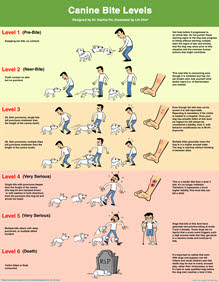Aggression between familiar dogs in the same household is a common occurrence and is one of the most common reasons that dogs are surrendered, rehomed, or euthanized. This aggression can be secondary to high arousal or excitement levels. When a fight occurs, damage to the relationship between the dogs can be difficult to repair.
There are a variety of factors that need to be considered when determining the future relationship between these dogs. For instance, aggression between female dogs is reported to be the most common and is the most difficult to treat due to the severity of injuries and intensity of aggression that occurs between the dogs. Fights between male dogs are often due to resource guarding and are the easiest to treat. Other indicators for poor outcome include:
Canine Bite Levels Poster

Photo Courtesy of CattleDog Publishing
- fights escalating in intensity.
- fights occurring between two female dogs of similar size and age.
- no noticeable early warning signs or triggers.
- level three bite or above.
As with any behavioral concern, the first step is looking for underlying medical causes contributing to the behavior.
Treatment Plan
When aggression occurs between familiar dogs, the initial goal of the treatment plan should focus on improving the welfare for both dogs. Although it can be difficult, there should be complete separation of the dogs with no visual contact. Leashes, gates, and tethers can be useful.
Monitor body language of each dog. Since dogs are often very subtle with body language monitor closely for hard stares or stiff posture that is signaling to another dog that they are uncomfortable. It is important that both dogs be completely relaxed in close proximity to each other. Direct stares (longer than three seconds) need to be quickly redirected to reduce escalating tensions.
Basket muzzle training is very important for safety. All dogs should be conditioned to wear a muzzle. This is not a punishment but rather a predictor of good things. Go slow and always wait for each dog to put their own nose into the muzzle. We never force it on, and the dog must willingly place their nose in the muzzle. We never advance it on them.
The dogs should never be together until they are 100% comfortable wearing their muzzles. A muzzle with a buckle is ideal as plastic clasps can break easily. A Baskerville Ultra or Jafco Muzzle with the end square for treat dispensing would be best.
Once comfortable in muzzles you can start walking them next to each other, one adult per dog. This is a great way to rebuild their relationship.
Teaching alternative behaviors such as “touch” is a great behavior to teach your dogs. It can be used to redirect a dog when needed. It can also be used to teach new behaviors and even as an emergency recall.
Teach your dogs to relax on a mat. This can be used later if the dogs are to be reintroduced.
Establish a safe haven such as a crate or room for all dogs. Make sure good things happen in this area. Food dispensing, puzzle toys, classical music and pheromones, can be helpful. A tether or gate may be necessary. If using a crate, be sure to cover and place them out of sight from each other.
Practice Cue-Response-Reward interactions with each dog. A Cue-Response-Reward interaction system encourages predictability and consistency therefore reducing overall anxiety and instability in the relationship between the dogs.
Learn to Earn Poster

Photo courtesy of CattleDog Publishing
Phase II
Once both dogs are comfortable wearing muzzles and relaxing on their mat.
- Initially, bring them out for short periods together.
- One adult per dog and sit on opposite sides of the room. A tether may be necessary.
- Give them something to do, like a long-lasting treat or toy giving the dogs an opportunity to be together, stay calm and relearn to like each other.
Always separate when they cannot be directly supervised with your entire attention.
Medications
In many cases medications for one or both dogs may be needed to lower anxiety.